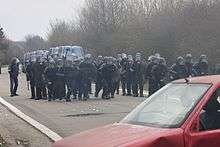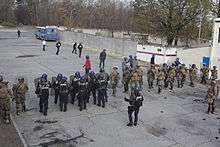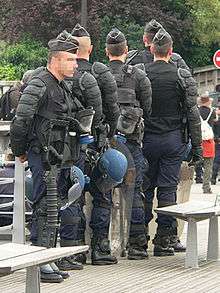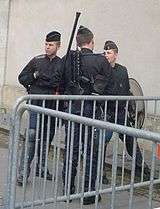Mobile Gendarmerie
The Mobile Gendarmerie (French: Gendarmerie mobile) (GM) is a subdivision of the French National Gendarmerie whose main mission is to maintain public order and general security. Contrary to the Departmental Gendarmerie, whose jurisdiction is limited to specific parts of the territory, the Mobile Gendarmerie can operate anywhere in France and even abroad as a component of the French Armed Forces. Although the term "mobile" has been used at different times in the 19th century, the modern Mobile Gendarmerie was created in 1921.
The Mobile Gendarmerie is nicknamed la jaune (the yellow one) because of its golden rank insignia, the traditional color of infantry in the French Army (most Gendarmerie units wear the silver insignia of the cavalry and other mounted arms).
The Mobile Gendarmerie is often mistaken with the National Police's CRS, as their missions are similar, but they have a different status, military for the gendarmes and civilian for the CRS.[1]
History
The term "mobile" was used at various times in the 18th and 19th century to name various Gendarmerie or mixed Gendarmerie-Army units : mobile battalions, mobile columns etc. engaged in public order duties. By the beginning of the 20th century, it was realized that there was a need for an intermediate force between the Police and the Army, which until then had been frequently called upon in case of trouble, very often with disastrous results (fraternization in a few cases, excessive violence in most of the others). Still, many lawmakers were reluctant to create a force which - they thought - might become a new Praetorian guard.[2]
In 1921, it was finally decided to create "Mobile Gendarmerie platoons" in the Departmental Gendarmerie. In 1926, the platoons formed the "Garde Républicaine mobile" (GRM),[3] which became a separate branch in 1927, the platoons becoming part of companies and legions. By 1940, the GRM was a force 21.000 strong, composed of 14 Légions, 54 company groups and 167 companies.[4]
Long the only large force specialized in maintaining or restoring law and order, the GRM progressively developed the doctrine and skills needed in that role : exercise restraint, avoid confrontation as long as possible, always leave an "exit door" for the crowd etc.[5]
More than 6.000 GMR gendarmes fought in 1940 either in line Gendarmerie combat units or as detached personnel seconded to the Army. After the 1940 armistice, the Germans demanded that the GRM be disestablished. A new organization, 6.000 strong, called "La Garde" was created and was attached, first to the minimal French Army remaining in the unoccupied zone, then after the whole country was occupied in the wake of the Allied landings in Africa in November 1942, to the Ministry of Interior. Being attached to the cavalry branch of the Army, the Garde traded its companies for squadrons.[6]
After the Liberation, the Garde was disbanded and the GMR recreated under the new designation of Garde républicaine.[7] In 1954, it acquired its present name of Gendarmerie mobile.[8]
The Garde républicaine/Gendarmerie mobile fought during both Indochina and Algerian conflicts, its main missions remaining first, that of maintaining law and order and second, to assist the Departmental Gendarmerie in its general security role. During the post-war years, all new Gendarmes started their carrier in the Mobile Gendarmerie.
In 2009, the Gendarmerie, while remaining part of the French Armed Forces, was attached to the Ministry of the interior, which already supervised the National Police, without changes to its missions. As a consequence of that change, the formal requisition process which the Ministry of the interior needed in order to use Mobile Gendarmerie forces (just like any other military force) is not used anymore.
Missions

The GM's main missions include:[9]
- crowd control and security during demonstrations and public events
- riot control
- reinforcement of the Departmental Gendarmerie in its general security missions
- participation in missions of the French Armed Forces abroad (called "external operations" or Opex).
Organisation


The territorial organisation of the GM is as follows:
- 7 "Zonal Gendarmerie Regions" corresponding to the 7 metropolitan National Defense Zones.
- 18 Mobile Gendarmerie Groupings (French: Groupements de gendarmerie mobile) including 1 armoured grouping based in Satory, near Versailles in the Paris area.
- 109 squadrons [10](French: Escadrons de gendarmerie mobile or EGM), each led by a major or a captain.
- 1 National Gendarmerie Intervention Group (GIGN) with six metropolitan GIGN branches. Their missions include counter-terrorism, hostage rescue, surveillance of national threats, protection of government officials and targeting of organized crime.[11] GIGN is able to deploy a 200 men hostage rescue team to manage a major crisis.
- approx. 12.000 personnel.
The Gendarmerie has a dedicated training facility, the National Gendarmerie forces training center (French: Centre national d'entraînement des forces de gendarmerie), in Saint-Astier (Dordogne), which duplicates an urban environment. Every squadron takes a two-week refresher training in riot-control techniques there every second year.
18 to 20 of the 109 squadrons are permanently deployed on a rotational basis in the French overseas departments and territories.
Until 2015, there used to be Reserve Mobile Gendarmerie squadrons but they were disestablished and all reserve personnels are now regrouped in reserve Departmental Gendarmerie units.
Zonal Gendarmerie Regions
Since 2016, metropolitan France has been divided into 12 administrative regions (+ Corsica) and the Departmental Gendarmerie has followed this pattern with 13 Gendarmerie Regions.[12] The general officer in charge of a region whose capital is also the seat of a Defense Zone (called a Zonal Region) heads all Mobile Gendarmerie forces of that region.[13] The number of Zonal regions, which went down from 9 to 7 in 2000, was left unchanged in the 2016 reform.
Mobile Gendarmerie Groupings
A grouping (French: Groupement de gendarmerie mobile or GGM) is an administrative echelon under the command of a lieutenant-colonel or a "full" colonel. Groupings include from four to ten squadrons. Where the situation so warrants (large demonstrations or public events etc.), squadrons from different groupings can be gathered into a Tactical Gendarmerie Grouping (French: Groupement tactique de gendarmerie or GTG) under the operational command of a grouping commander. If need be, several GTGs form an "operational grouping for maintaining order" (French: Groupement opérationnel de maintien de l'ordre or GOMO) under the command of a full colonel.[14]
Mobile Gendarmerie squadrons


A mobile squadron of gendarmes (French: Escadron de gendarmerie mobile or EGM) is composed of:[15]
- 115 personnel members.
- Four line platoons including one "Intervention" platoon and three regular platoons.
- The Intervention Platoon (Peloton d'Intervention) is specialized in difficult riot control missions such as arrest of violent demonstrators etc. It also reinforces the departmental Gendarmerie for high risk judicial arrests. It is formed of 18 gendarmes, whose particular missions (arrests, escorts…) require specialised training and equipment.
- One headquarters platoon (French: Peloton hors rang)"Hors rang" in charge of administration and logistics.
There are two types of GM squadrons: regular squadrons and armoured squadrons of the armoured Grouping equipped with VBRG armoured wheeled vehicles (French: Véhicule Blindé à roues de la Gendarmerie).
Each squadron (EGM) is identified by a three-digit number e.g.: EGM 15/6 in Nîmes.
- 1st digit = number of the mobile grouping in the region.
- 2nd digit = number of the squadron in the grouping.
- 3rd digit = number of the zonal region.
National Gendarmerie Intervention Group (GIGN)

- See also: GIGN
Groupe d'intervention de la Gendarmerie nationale is the elite law enforcement and special operations unit of the French National Gendarmerie. Its missions include counter-terrorism, hostage rescue, surveillance of national threats, protection of government officials and targeting of organized crime.[16]
Although administratively part of the Mobile Gendarmerie, GIGN reports directly to the Director general of the Gendarmerie Nationale (DGGN) i.e. the chief of staff of the Gendarmerie. The DGGN can take charge in a major crisis; however, most of the day-to-day missions are conducted in support of local units of the Departmental Gendarmerie.
In addition to the main unit, based in Satory (Versailles near Paris), there are six GIGN regional branches which are each administratively attached to a separate Mobile Gendarmerie Grouping. They are under the operational control of their Zonal regions and operate under GIGN supervision.
Gallery
-

Two gendarmes mobiles in anti-riot gear
-

Riot control gear: body armour, shield, tear gas mask, apparatus for throwing tear gas canisters
-

Using tear gas during the 2007-05-06 anti-Nicolas Sarkozy demonstrations at the Bastille.
-

More use of tear gas.
-

anti-riot version of the SPECTRA helmet used by the Gendarmerie Mobile
References
- ↑ Both the press and the man in the street frequently call "CRS" any policeman in riot gear and wearing a helmet, whether he is a true CRS, a policeman, or a gendarme mobile. CRS and gendarmes can be distinguished by the color of their helmets (blue for the gendarmes, black with two yellow stripes for the CRS. The CRS also wear a big red CRS patch.
- ↑ Encyclopédie de la Gendarmerie nationale, tome III
- ↑ Not to be confused with the Groupes mobiles de réserve (GMR) created by the Vichy regime during the Second World War, which were superseded by the CRS at the end of the war.
- ↑ Historique de la Gendarmerie (guide de recherche) - Service Historique de la Défense, Vincennes.
- ↑ Maintenir l'Ordre (in French) - Patrick Bruneteaux - Presses de Sciences Po, Paris 1996
- ↑ La Garde sous Vichy, Claude Cazals.
- ↑ The current Garde républicaine was then known as "Garde républicaine de Paris".
- ↑ Histoire de la Gendarmerie mobile d'Île-de-France
- ↑ Encyclopédie de la Gendarmerie Nationale, tome III
- ↑ Squadron in the British sense of the term. The equivalent US unit would be a troop or a company
- ↑ Peachy, Paul. "Who are GIGN? Elite police force formed after 1972 Olympics attack on Israelis". The Independent. The Independent. Retrieved 27 April 2016.
- ↑ Prior to the 2016 reform, there were 22 administrative regions and 22 Gendarmerie regions.
- ↑ From 1991 to 2005, the Groupings of a given Zonal Region formed a Mobile Gendarmerie Legion. Since 2005, they report directly into the Zonal Region.
- ↑ Histoire de la gendarmerie mobile d'Île-de-France
- ↑ Encyclopédie de la Gendarmerie nationale, tome III
- ↑ Encyclopédie de la Gendarmerie nationale, tome III
Bibliography
- Collective (2006). Encyclopédie de la Gendarmerie Nationale, tome III (in French). éditions SPE Barthelemy, Paris. ISBN 2-912838-21-5.
- Collective (2007). Histoire de la Gendarmerie mobile d'Ile-de-France (in French). éditions SPE Barthelemy, Paris. ISBN 2-912838-31-2.
- Bruneteaux, Patrick (1996). Maintenir l'Ordre (in French). Presses de Sciences Po, Paris. ISBN 2-7246-0676-0.
- Carrot, Georges (1990). Le Maintien de l'ordre en France au 20e siècle (in French). éditions Veyrieur, Paris. ISBN 2-85199-535-9.
- Cazals, Claude (1997). La Garde sous Vichy (in French). éditions La Musse, Paris. ISBN 2-904016-01-5.
